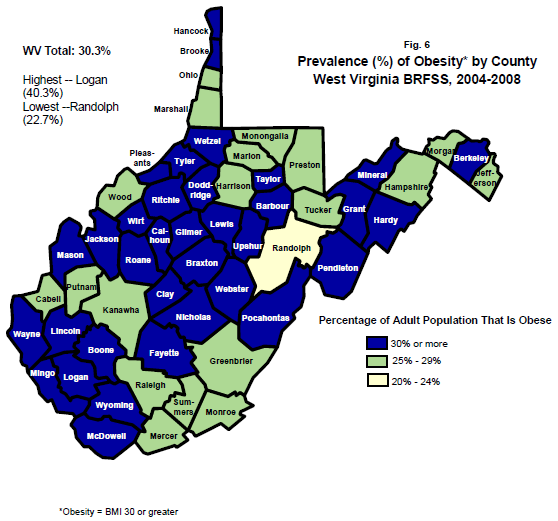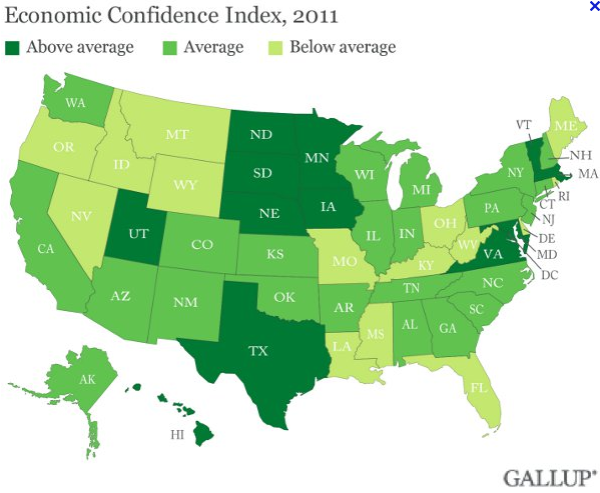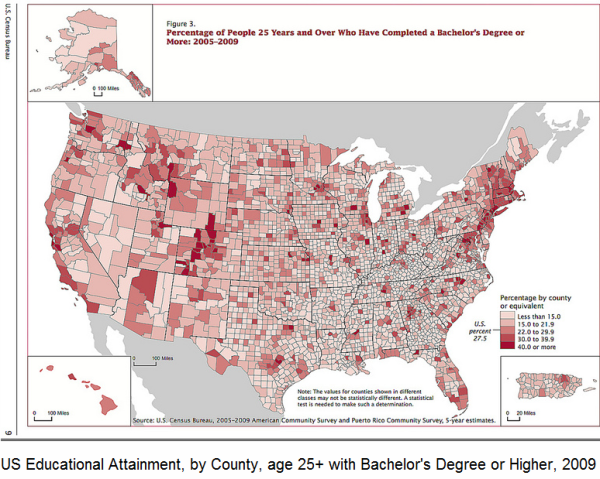West Virginia is the #3 “Most Obese” State in the U.S.
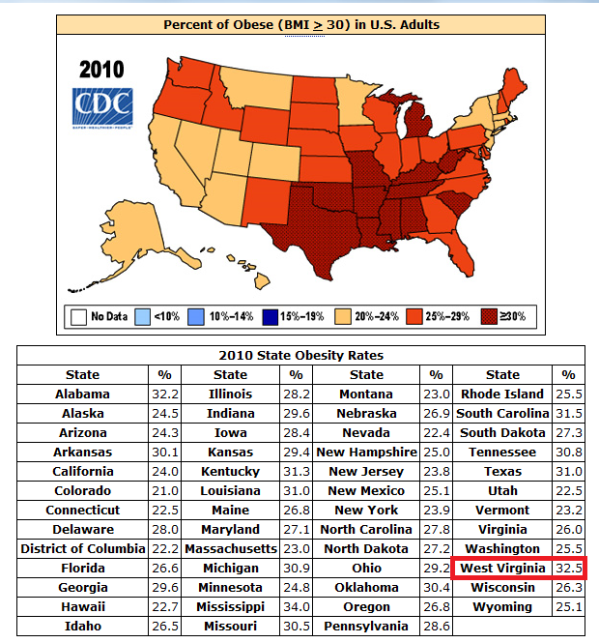
Source: Centers for Disease Control. http://www.cdc.gov
According to the Center’s for Disease Control, nearly two-thirds of West Virginian adults are overweight (BMI>;25) and nearly one-third are obese (BMI>;30). The statistics are alarming, but the data that worries me the most is the rate of childhood obesity. In West Virginia, 14.4 % of children ages 2-5 are overweight (85th to ;95th percentile BMI-for-Age). These numbers stay consistent in kids up to 18 years old.
Obesity in WV is Correlated With Being “Unhealthy”
According to the CDC’s Behavior Risk Factor Surveillance System (BRFFS), the obesity rate in WV has increased by 4.6% since 1989. If obesity keeps growing at this shocking rate, by the year 2018 nearly HALF of all West Virginians will be obese! If this holds true in the year 2018, the Nat’l Board of Economic Research estimates that obesity will cost the state of WV nearly $2.3 billion dollars. But why does obesity matter? Why is obesity such a “big” deal anyway?…Obesity is important because it contributes to an individual’s overall health. In fact, West Virginia is ranked #1 in the U.S. for the prevalence of cardiovascular mortality, diabetes, and hypertension (as shown by the graphs below).

West Virginian residents who were obese were less likely to report their overall health as “Excellent/Very Good”.Source: West Virginia DHHR Bureau for Public Health. Obesity in West Virginia. 2011
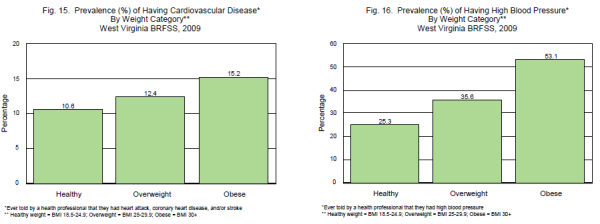
Obese individuals have the highest rates of cardiovascular disease and hypertension.
Source: West Virginia DHHR Bureau for Public Health. Obesity in West Virginia. 2011
How does your WV county stack up?
Factor’s Contributing to West Virginia’s Obesity Epidemic
So the million dollar question is: Why are so many West Virginian’s overweight or obese?
The answer is not a simple one. Obesity is a complex issue that involves both genetic and environmental factors. But what is it about the environment in West Virginia that is making it’s residents SO unhealthy and SO overweight?
1. Fruit and Vegetable Consumption: A healthy diet is probably the most important factor in maintaining a healthy weight. The diet of West Virginian’s, however, is of poor quality. Everywhere you turn there’s a fast food joint offering fatty convenience foods. But, like in any region, the food is just a part of the culture. For example, the pepperoni roll is famous in WV since it was invented in Fairmont, WV around 100 years ago. Good old southern cooking is absolutely delicious…there’s no denying that. But there is also no denying how unhealthy it can be as it’s fried up in butter, fat, and salt.
Not to mention, West Virginian’s aren’t eating enough fruits and vegetables. According to the 2007 CDC BRFFS, fruit and vegetable consumption in this state is very LOW. West Virginian adults consuming 2 or more servings of fruits daily was only 24.9%, compared to a national average of 32.8%. And West Virginian adults consuming 3 or more servings of vegetables daily was only 26% compared to the national average of 27.4%.
2. Access to Healthy Foods: To give a picture of the overwhelmingly easy access to fatty, fried, fast foods…here is another alarming statistic: In Huntington County, WV (which is in the #1 most obese county in the entire country!) there are more pizza joints than there are health clubs available in the entire state!
3. Physical Inactivity: The state of WV used to be bustling with manufacturing jobs, mostly coal mining. In recent years, however, the coal mining industry has been on the downfall and the manufacturing jobs that used to require strenuous labor and physical activity are now not as readily available to it’s residents.
As you can see in the figure below, West Virginian’s are more physically INactive compared to the national average rates. According to the CDC BRFFS, 33.2% of West Virginians reported physical inactivity compared to the national average of 24.2%.
4. Access to Community Streets/Sidewalks: West Virginia, “Wild and Wonderful”, undoubtedly has the most beautiful landscape of all the U.S. states. Wouldn’t that encourage people to get outside and enjoy the beauty that surrounds them? Well, you would think. But have you ever tried to walk, run, or bike along any streets in WV? It is QUITE a dangerous endeavor. Cars zip by as they swerve around narrow and hilly back-country roads. And there are nearly no sidewalks available for people to use…unless of course you’re willing to get in your car and drive somewhere that has a safer place to walk or bike (but whose going to do that?). In addition, WV has yet to pass the Complete Streets legislation, which aims to ensure that pedestrians, bicyclists, and motorists have safe access to community streets.
5. The Economy: Having a low SES status can sometimes be an indicator of the overall health of an individual. According to a Gallup poll, WV ranked as having the LOWEST score in an economic confidence index.
6. Education: According to the U.S. Census Bureau, WV has the LOWEST rate of attaining a Bachelor’s degree. In WV, only 17.3% of the population will get a college education.
7. Dental Problems: West Virginia has the HIGHEST rate of tooth loss in the U.S. Nearly one-third of adults by the age of 35 have lost at least 6 or more permanent teeth and 42% of WV adults over the age of 65 have lost ALL of their natural teeth.
Having a toothless smile is no laughing matter. Having little or no teeth truly does affect a person’s ability to consume food. After all, would you be able to bite into an apple or chomp on a salad without having any teeth?
8. Disabilities: West Virginia has the HIGHEST rate of disabilities according to the U.S. Dept. of Commerce. The study looked at individuals ages 16-64 years old with disabilities that included functional limitations in physical, mental, and communication disabilities, limitations in activities of daily living (ADL) and instrumental activities of daily living (IADL).
Being physically disabled affects a person’s ability to exercise and burn off extra calories…thus causing more subsequent weight gain.
9. Depression: West Virginia is tied with Mississippi for the HIGHEST rate of depression in the U.S. according to the CDC. Nearly 5.3% of adults in WV meet the criteria for clinical depression.
10. Overall Well-Being: According to a Gallup poll that took into account diabetes, frequency of physical activity, consumption of produce, city optimism, and the uninsured – WV ranked as having the LOWEST score of overall well-being.
11. Lack of Registered Dietitians: According to an article in the Journal of the Academy of Nutrition and Dietetics, WV has the second lowest number of Registered Dietitians (RDs) per capita in the state. With only 17 RDs per 100,000 WV residents, this creates a lack of access to accurate nutrition information and accredited nutrition professionals to combat the obesity problem.
_______________________________________________________________________________________________________________________
BOTTOM LINE: Needless to say, the state of West Virginia has A LOT of confounding factors contributing to it’s obesity epidemic and Registered Dietitians have A LOT of work to do in the future. So we know the obesity problem exists, but how can we fix it? Well…I’ll have to save that blog post for some other time. 🙂
Sources:
West Virginia Department of Health and Human Resources Bureau for Public Health. Obesity in West Virginia. 2011. http://www.wv.gov/news/Pages/DHHRpublishes%E2%80%98ObesityinWestVirginia%E2%80%99report.aspx
http://www.msnbc.msn.com/id/27697364
http://www.gallup.com/poll/125066/State-States.aspx
Haughton B, Stang J. Population risk factors and trends in health care and public policy. J Acad Nutr & Dietetics. Supp, March 2012.
http://www.wsaz.com/news/headlines/27955649.html


